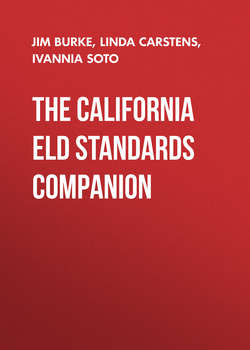Читать книгу The California ELD Standards Companion, Grades 3-5 - Jim Burke - Страница 23
На сайте Литреса книга снята с продажи.
Grades 3–5 Interacting in Meaningful Ways Collaborative Standard 1
ОглавлениеWhat the Teacher Does
[Children] engage in discussion with others to clarify points; ask questions; summarize what they have heard, read, or viewed; explain their opinions; and collaborate on projects, research, and presentations. They acquire language for new concepts through reading and listening and use this language in speaking and writing (2014 English Language Arts/English Language Development Framework [ELA/ELD], p. 286)
As in Grades K–2, the emphasis on speaking and listening continues, but the expectations and routines should become more complex. Although basic routines can be reviewed at the beginning of the school year, ELLs should be taught more complex skills such how to clarify ideas, question, summarize, and provide detailed explanations for their opinions. Providing more complex sentence frames connected to these skills—such as What do you mean? or I have a question about ______ for clarification and Based on ______, I infer that _______ or I hypothesize that ______ for predicting—are important to prompt student thinking and language can scaffold these complex skills.
ELLs should also move from merely one-on-one interactions and into collaborative or group-worthy tasks. One way to have student practice complexity, language, and collaboration is by using reciprocal teaching roles, where students are taught how to lead conversations on their own with roles such as summarization, questioning or clarification, predicting, and connecting.
Students’ language develops when they have ample opportunities to hear, read, and use language in speaking and writing. Therefore, teachers should serve as excellent models of language use and ensure that children have many opportunities to use language for a variety of purposes in a variety of stimulating contexts. Classrooms that are silent for hours suggest lost opportunities for language development (ELA/ELD, p. 295).
In order to move away from silent classrooms and into collaboration, language must be thoughtfully planned for by the teacher in advance and connected to the curriculum. One way to do this is by identifying the most cognitively and linguistically demanding skills or tasks being taught and by providing stopping points for student talk during these times. Another key shift within this grade span is that students should be required to talk across content areas and not merely during language arts or ELD time (see Vignette 4.3).
